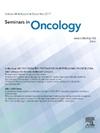突破障碍:解读前列腺癌奥拉帕尼耐药机制
IF 2.5
3区 医学
Q2 ONCOLOGY
引用次数: 0
摘要
奥拉帕尼是一种聚adp核糖聚合酶(PARP)抑制剂,在治疗DNA损伤修复基因突变的转移性去势抵抗性前列腺癌(mCRPC)中显示出显著的临床疗效。虽然最初的反应是令人鼓舞的,但耐药性的出现构成了一个主要的临床问题,降低了患者的长期治疗价值。本文深入研究了前列腺癌(PCa)获得性和内在奥拉帕尼耐药背后的分子过程。发现的几种抗性途径包括通过继发性BRCA2突变恢复同源重组(HR)修复能力,53BP1/REV7/ shield复合物活性的丧失,以及其他DNA修复途径的激活。最近的研究进一步表明,细胞周期检查点的变化和表观遗传变化可能有助于进一步增加治疗耐药性。了解这几种耐药机制有助于制定合理的组合策略和生物标志物驱动的举措,以击败奥拉帕尼耐药。新的治疗选择包括针对补偿性DNA修复机制的联合治疗、细胞周期检查点抑制剂、表观遗传调节剂和处理肿瘤微环境因素的方法。预测耐药生物标志物的发现将有助于指导个体化治疗选择和序贯治疗优化,从而改变精准医学时代晚期PCa患者的临床结果。本文章由计算机程序翻译,如有差异,请以英文原文为准。
Breaking barriers: Deciphering the mechanisms of Olaparib resistance in prostate cancer
A poly (ADP-ribose) polymerase (PARP) inhibitor, Olaparib has shown notable clinical effectiveness in treating metastatic castration-resistant prostate cancer (mCRPC) with DNA damage repair gene mutations. Though initial reactions were encouraging, the emergence of resistance poses a major clinical problem that reduces the long-term therapeutic value for patients. This paper thoroughly investigates the molecular processes behind acquired and intrinsic resistance to Olaparib in prostate cancer (PCa). Among the several resistance routes discovered are restoration of homologous recombination (HR) repair capacity via secondary BRCA2 mutations, loss of 53BP1/REV7/Shieldin complex activity, and activation of alternative DNA repair pathways. Recent studies further imply that changes in cell cycle checkpoints and epigenetic changes could help to increase therapy resistance even more. Knowing these several resistance mechanisms helps one to create reasonable combination strategies and biomarker-driven initiatives to defeat Olaparib resistance. Among the new treatment options are combination therapies aimed at compensatory DNA repair mechanisms, cell cycle checkpoint inhibitors, epigenetic modulators, and methods tackling tumor microenvironment elements. Predictive biomarker discovery of resistance will help to guide individual treatment choice and sequential therapy optimization, hence changing clinical results for advanced PCa patients in the precision medicine age.
求助全文
通过发布文献求助,成功后即可免费获取论文全文。
去求助
来源期刊

Seminars in oncology
医学-肿瘤学
CiteScore
6.60
自引率
0.00%
发文量
58
审稿时长
104 days
期刊介绍:
Seminars in Oncology brings you current, authoritative, and practical reviews of developments in the etiology, diagnosis and management of cancer. Each issue examines topics of clinical importance, with an emphasis on providing both the basic knowledge needed to better understand a topic as well as evidence-based opinions from leaders in the field. Seminars in Oncology also seeks to be a venue for sharing a diversity of opinions including those that might be considered "outside the box". We welcome a healthy and respectful exchange of opinions and urge you to approach us with your insights as well as suggestions of topics that you deem worthy of coverage. By helping the reader understand the basic biology and the therapy of cancer as they learn the nuances from experts, all in a journal that encourages the exchange of ideas we aim to help move the treatment of cancer forward.
 求助内容:
求助内容: 应助结果提醒方式:
应助结果提醒方式:


